As artificial intelligence becomes more prominent in the creative world, Studio Ghibli has made its stance clear: it champions the artistry of hand-drawn animation over AI-generated works. This declaration came from GKids, the North American distributor for Ghibli films, following the launch of a 4K restoration of Princess Mononoke. The restoration has already made waves, grossing $1.2 million in previews and reaffirming the enduring appeal of Ghibli’s traditional animation style.
Chance Huskey, VP of distribution for GKids, commented, “In a time when technology tries to replicate humanity, we are thrilled that audiences value a theatrical experience that respects and celebrates Hayao Miyazaki and Studio Ghibli’s masterpiece in all its cinematic hand-drawn glory.” The statement, while celebrating Princess Mononoke’s timeless artistry, subtly rebukes the growing trend of AI-generated art that attempts to replicate Ghibli’s signature visuals.
Ghibli’s Legacy: Defending Traditional Animation Against AI Threats

The rise of AI-generated art has sparked significant concerns within the creative community, especially after OpenAI launched a tool that mimics various art styles, including Ghibli’s. AI-generated content quickly flooded social media, with many creators feeling that it undermines the effort and skill behind traditional animation. Miyazaki himself has long been outspoken about his disdain for AI, calling it “an insult to life itself” in 2016, reinforcing his belief that animation should reflect human emotion and craftsmanship rather than automation.
Studio Ghibli’s films, particularly those directed by Miyazaki, are renowned for their meticulous, hand-drawn style, which has influenced generations of animators and artists. The studio’s dedication to preserving this form of artistry is reflected in the personal involvement of its creators. For instance, Akihiko Yamashita, supervising animator for Howl’s Moving Castle, stated that Miyazaki personally oversees every frame of production, often redrawing scenes until they meet his exacting standards.
The Growing Debate: AI in Art and the Fight for Authenticity

While some view AI-generated art as a form of tribute or homage to the classic styles of revered artists like Miyazaki, others see it as a devaluation of the craft. Ghibli’s latest statement and its ongoing efforts to promote hand-drawn animation signal its commitment to preserving the legacy of traditional artistry. The increasing use of AI in art, especially in replicating established styles, raises critical questions about the authenticity of creative work and the role of technology in shaping the future of animation.
The conversation surrounding AI-generated art is not just about the technical capabilities of these tools but also about the potential erosion of the creative process. For studios like Ghibli, the emotional depth and human touch inherent in their work are what distinguish it from the growing trend of automated creativity. As AI tools become more sophisticated, the line between tribute and exploitation continues to blur, leaving the future of traditional animation uncertain.





